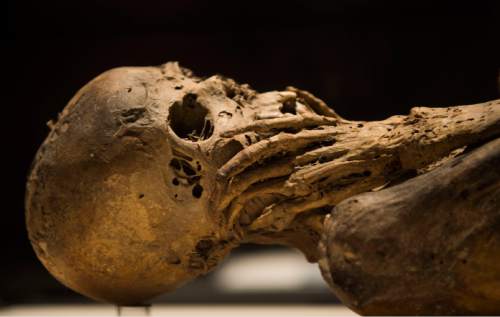This is an archived article that was published on sltrib.com in 2015, and information in the article may be outdated. It is provided only for personal research purposes and may not be reprinted.
I can't say that I totally disagree with the Public Forum letter published in The Salt Lake Tribune Thursday. The one about how The Leonardo museum in downtown Salt Lake City seems to have a gruesome fascination with dead things.
— Cut the gore, Leonardo — Public Forum | Salt Lake Tribune
"Why is the Leonardo so often the site of ghoulish and grisly exhibitions?
"Two exhibits of flayed human corpses, one of flayed non-human animals and now another mummies show. The gruesome banners around the town make everyone hostage to this strange subject matter and give the city a touch of horror.
"Not much like our longtime effort to appear wholesome. How about science presented as valuable and interesting rather than an excuse for sensationalism?
"Leslie Thomas
"Salt Lake City"
— Unwrapping the stories of mummies at The Leonardo — Sheena McFarland | Special to The Tribune
I've not taken in the displays of preserved human and animal bodies, or of ancient and not-so-ancient mummies. But that's because I've got a pretty low tolerance for ick.
The namesake of the museum, however, apparently did not. Dissecting people was something he was very good at. It helped him become one of the greatest artists of all time. And, if he had been allowed to publish his findings instead of having to keep them secret (dissecting people was illegal), science could have moved forward much more quickly.
— Leonardo da Vinci: Anatomy of an artist — Alastair Sooke | The Telegraph
"If Leonardo da Vinci's uncannily accurate studies of the human body had been published in his lifetime, they would have changed the course of science..."
" ... One day, probably during the winter of 1507-08, Leonardo da Vinci found himself chatting with an old man in the hospital of Santa Maria Nuova in Florence. Sitting on a bed, the man revealed that he felt nothing wrong with his body other than weakness, despite being more than 100 years old. 'And thus,' Leonardo recorded, 'without any movement or sign of any mishap, he passed from this life. And I dissected him to see the cause of so sweet a death.' It was not the first time that Leonardo had sliced into a corpse: by 1508, by his own reckoning, he had conducted more than 10 human dissections. Nine years later, this tally had risen above 30. But his study of the cadaver 'del vechio' (of the old man), as Leonardo called him, rekindled his long-held obsession with the structure of the human body. ..."
— Leonardo da Vinci and Dissection — Nicole Chiemi | The Art | Crime Archive
"Leonardo da Vinci, who lived from 1452-1519, is well known for his anatomical sketches of the human body. He would dissect dead human remains and then draw what he saw.
"Dissection was completely illegal unless one was a physician, which da Vinci was not. It is believed that da Vinci would get a grave robbers, and eventually a hospital director to get him cadavers to study. da Vinci hid all of this anatomical drawings and kept them secret because of the illegal nature of what he was doing. He was able to identify not only muscles and bones, but also their functions in the body, which was an incredible breakthrough. Sadly, he was not able to share any of this knowledge with others, once again, because of the illegal nature of what he was doing.
"da Vinci believed only that in which he could observe, which is probably one of the reasons he resorted to dissection to learn more about the human body. ..."



